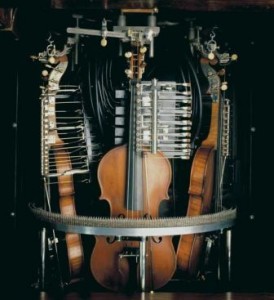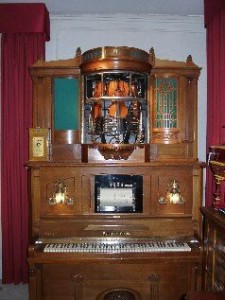Hupfeld’s ‘violin player’ was one of the marvels at the World’s Exhibition of 1910 in Brussels.
The Hupfeld Phonoliszt Violina was made in Germany by Ludwig Hupfeld.
Hupfeld was the world’s leading manufacturer of automatic pianos and orchestrions, 1892-1930. They also made rolls circa 1934. Founded in 1892 when Ludwig Hupfeld took over J.M Grob & CO. ultimately employed over 2500 people in several factories, the largest including about 1 million square feet of floor space.
The Hupfeld company made a variety of instruments including phonola push up piano players and player pianos, phonoliszt, expression pianos, DEA, and triphonola reproducing pianos, Universal, Clavitist, Helios, Pan, Animatic, and Symphony Jazz orchestrions, Phonoliszt-Violina and Violina orchestra violin players, among other instruments. The company has continued to make hand played pianos to the present.
The method used in building orchestrions, i.e. to play several instruments in a case with a control mechanism, was also used at the beginning of the 20th century to provide a self-playing “classical” piano and violin combinations. The Hupfeld Company invented a device in 1907 which was dubbed the “8th wonder of the world” for automating the violin part. Three violins (each with only one active string) mounted vertically were played by a round rotating bow made of 1300 threads of horse hair, according to the program on the roll of perforated paper. The small bellows replaced the violin player’s fingers, pressing on the strings to obtain the necessary notes. The piano can be driven either unaccompanied or together with the violins. It controls 38 accompaniment keys with 12 high notes (one octave) in extension. The whole pneumatic systems are controlled by an electric engine of uninterrupted current. The Hupfeld Company sold this type of instrument for 20 years without any competitors.
The Hupfeld was available in at upright home and commercial versions, including coin-operated version with a 10-station roll changer.
This machine is truly a sight to see.


Leave a Reply